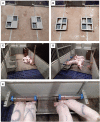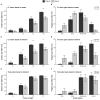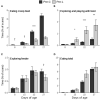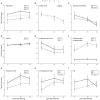Assessing the Effectiveness of Providing Live Black Soldier Fly Larvae (Hermetia illucens) to Ease the Weaning Transition of Piglets
- PMID: 35252425
- PMCID: PMC8890697
- DOI: 10.3389/fvets.2022.838018
Assessing the Effectiveness of Providing Live Black Soldier Fly Larvae (Hermetia illucens) to Ease the Weaning Transition of Piglets
Abstract
Weaning is a stressful event for piglets, involving substantial changes to their nutritional and social environment. Providing edible enrichment around weaning may ease the weaning transition by increasing pre-weaning feed intake and improving post-weaning performance, health, behavior, and affective state. In this study, we investigated the effects of providing live black soldier fly larvae (BSFL) as edible enrichment pre- and/or post-weaning. Pre-weaning, piglets received either only creep feed (Pre-C, n = 14 litters) or creep feed and live BSFL (Pre-L, n = 15 litters) ad libitum, and post-weaning piglets either had no access to live BSFL (Post-C, n = 24 pens) or they could rotate tubes that released BSFL (Post-L, n = 24 pens) at levels up to 20% of their expected daily dry matter intake, resulting in treatments CC, CL, LC, and LL. No interaction between pre- and post-weaning treatment was found for any of the measured parameters. Before weaning, Pre-L piglets preferred to interact with larvae over creep feed, and Pre-C piglets interacted more with creep feed than Pre-L piglets. Total time spent on feed-directed behaviors did not differ. Continuous larvae provisioning increased caecum length and proximal stomach digesta pH, while it decreased the passage of glucose and fluorescein isothiocyanate through the colon wall on d3 post-weaning (CC vs. LL, n = 12 piglets/treatment). Post-weaning diarrhea and final body weight were not affected by treatment. After weaning, Pre-C piglets tended to eat more and grew marginally faster than Pre-L piglets. Post-C piglets spent more time eating and had a higher feed intake post-weaning than Post-L piglets. Based on home-pen behavioral observations, Post-L piglets actively explored and ate the larvae. Post-C piglets spent more time on exploring the environment and nosing pen mates, and they spent more time on manipulating pen mates on d8 and played more on d8 & 15 compared to Post-L piglets. Piglet responses to a novel environment and an attention bias test on d4 & 5 post-weaning were not influenced by larvae provisioning. In conclusion, pre-weaning larvae provisioning did not improve pre-weaning feed intake and post-weaning performance, however post-weaning larvae provisioning did benefit piglet behavior as less manipulation of pen mates was observed.
Keywords: affective state; behavior; black soldier fly larvae (BSFL); enrichment; health; performance; piglet; weaning.
Copyright © 2022 Ipema, Gerrits, Bokkers, van Marwijk, Laurenssen, Kemp and Bolhuis.
Conflict of interest statement
The authors declare that the research was conducted in the absence of any commercial or financial relationships that could be construed as a potential conflict of interest.
Figures





References
-
- Newberry RC, Wood-Gush DGM. The suckling behaviour of domestic pigs in a semi-natural environment. Behaviour. (1985) 95:11–25. 10.1163/156853985X00028 - DOI
-
- Jensen P, Recén B. When to wean—-observations from free-ranging domestic pigs. Appl Anim Behav Sci. (1989) 23:49–60. 10.1016/0168-1591(89)90006-3 - DOI
-
- Weary DM, Jasper J, Hötzel MJ. Understanding weaning distress. Appl Anim Behav Sci. (2008) 110:24–41. 10.1016/j.applanim.2007.03.025 - DOI
-
- Hötzel MJ, de Souza GPP, Costa OAD, Machado Filho LCP. Disentangling the effects of weaning stressors on piglets' behaviour and feed intake: Changing the housing and social environment. Appl Anim Behav Sci. (2011) 135:44–50. 10.1016/j.applanim.2011.09.003 - DOI
LinkOut - more resources
Full Text Sources
Research Materials

